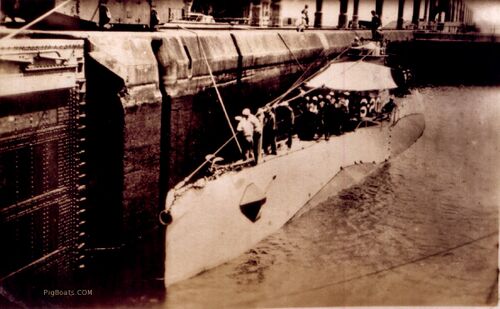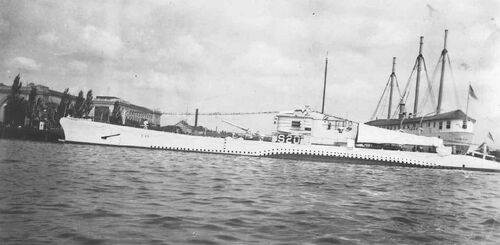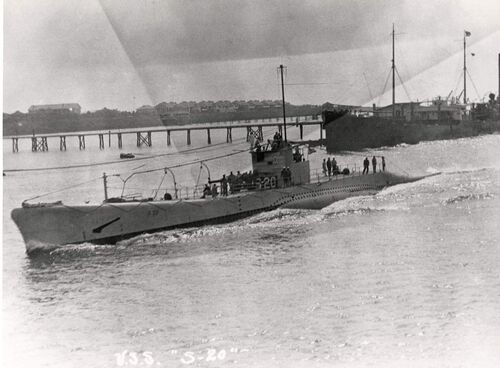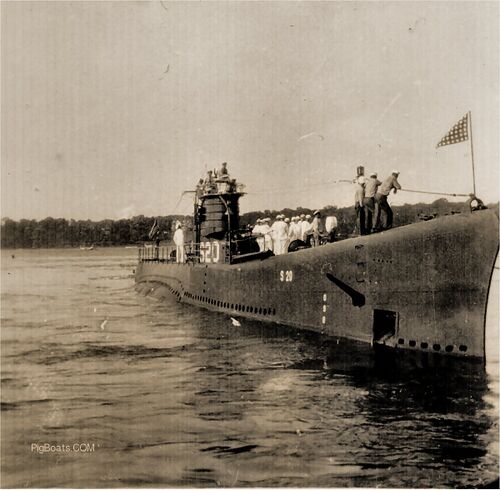S-20: Difference between revisions
Pbcjohnston (talk | contribs) Created S-20 page |
Pbcjohnston (talk | contribs) Added photos |
||
| Line 1: | Line 1: | ||
[[File:S-Boat Header 1.jpg]] | [[File:S-Boat Header 1.jpg]] | ||
<div style="text-align: justify;"><span style="color:#00008B"> | [[File:S-20 locks.jpg|left|500px]] | ||
<div style="text-align: justify;"><span style="color:#00008B">S-20 on one of her visits to the Panama Canal, locking through. There is just enough detail to show this is Panama. At the top left of the photo can be seen one of the "donkey" locomotives used to pull the vessels into and through the locks. | |||
A lock gate can be seen on the left and behind the submarine is another and the lock behind is higher than the shown lock which means the submarine is descending to sea level. She may be in a center lock or the last lock. It is unclear which direction she is proceeding. | |||
The time frame is most likely prior to her March 1924 to February 1925 conversion, when she became an engineering test platform, testing a variety of engine configurations. Her standard S-class bow was replaced with a radical new bow to test the sea keeping and submerged abilities of the new design. This type bow was to be used in the next class of submarines, the V-class and in a modified version was used in the later WWII boats and became known as a "fleet bow". | |||
<small>Photo from an original post card in the private collection of Ric Hedman</small> | |||
[[File:Red bar sub new.jpg]] | |||
[[File:S-20 tarp.jpg|left|500px]] | |||
<div style="text-align: justify;"><span style="color:#00008B">S-20 alongside at the Naval Academy in Annapolis, MD., late 1920's after her conversion. The radically altered bow and different shape of the superstructure is apparent in this photo. In the background on the right is the training and barracks ship USS Cumberland (IX-8). She was a long-term resident at the Academy. In this configuration she was unable to get underway and was used for pierside services only. | |||
<small>U.S. Navy photo</small> | |||
[[File:Red bar sub new.jpg]] | |||
[[File:S-20 port gray.jpg|left|500px]] | |||
<div style="text-align: justify;"><span style="color:#00008B">S-20 underway in the Canal Zone, late 1920's. As part of her conversion S-20 was also fitted with "saddle" style fuel tanks, attached to the outside of the outer hull. These provided her with an additional 5889 gallons of fuel. The saddle tanks are just visible in this photograph, amidships just above the wave and below the superstructure. | |||
<small>USN photo # NH 94167 via NHHC.</small> | |||
[[File:Red bar sub new.jpg]] | |||
[[File:S-20 anchored 1938.jpg|left|500px]] | |||
<div style="text-align: justify;"><span style="color:#00008B">In 1934-1935 the Navy made a force wide change to a flat black paint scheme for all submarines. This photo shows S-20 in the 1935 to 1939 time frame, with the exact location unknown, but we suspect it to be in the Severn River near Annapolis, MD. | |||
Note that the submarine is anchored. The anchor chain can be seen running out the anchor housing fairing. There are crew in both whites and dungarees on deck. A guess would be that liberty has been granted and the men are waiting for a launch to take them to the shore. Those not in whites are probably the duty section. This is just a theory since the real story is not known nor does it explain why there are so many officers on the bridge. Maybe the crew is returning from liberty and the sub is about to get underway. | |||
<small>Photo in the private collection of Ric Hedman</small> | <small>Photo in the private collection of Ric Hedman</small> | ||
[[File:Red bar sub new.jpg]] | |||
[[File:S-20 port black.jpg|left|500px]] | |||
<div style="text-align: justify;"><span style="color:#00008B">S-20 underway later in her career, possibly during WWII. The location is not known. | |||
<small>U.S. Navy photo</small> | |||
[[File:Red bar sub new.jpg]] | |||
[[File:Red bar sub new.jpg]] | [[File:Red bar sub new.jpg]] | ||
Revision as of 19:12, 16 July 2023

A lock gate can be seen on the left and behind the submarine is another and the lock behind is higher than the shown lock which means the submarine is descending to sea level. She may be in a center lock or the last lock. It is unclear which direction she is proceeding.
The time frame is most likely prior to her March 1924 to February 1925 conversion, when she became an engineering test platform, testing a variety of engine configurations. Her standard S-class bow was replaced with a radical new bow to test the sea keeping and submerged abilities of the new design. This type bow was to be used in the next class of submarines, the V-class and in a modified version was used in the later WWII boats and became known as a "fleet bow".
Photo from an original post card in the private collection of Ric Hedman

U.S. Navy photo

USN photo # NH 94167 via NHHC.

Note that the submarine is anchored. The anchor chain can be seen running out the anchor housing fairing. There are crew in both whites and dungarees on deck. A guess would be that liberty has been granted and the men are waiting for a launch to take them to the shore. Those not in whites are probably the duty section. This is just a theory since the real story is not known nor does it explain why there are so many officers on the bridge. Maybe the crew is returning from liberty and the sub is about to get underway.
Photo in the private collection of Ric Hedman

U.S. Navy photo
Page created by:
Ric Hedman & David Johnston
1999 - 2023 - PigBoats.COM©
Mountlake Terrace, WA, Norfolk, VA
webmaster at pigboats dot com
